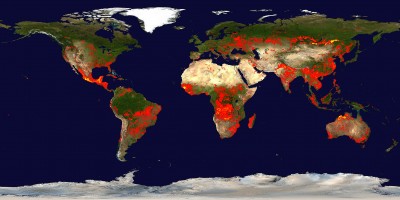Searching for Elusive Plumes in the United States
Published: 19 April 2013
Interview with scientists spearheading a research campaign: 120 flight hours through burning biomasses in the Pacific Northwest and Memphis this summer.
From “flash” to “smoldering” to”‘aging”—I’m not talking about men or women. It is fires—specifically those from burning organic matter, also called ‘burning biomasses.’
Fires are sparked by a large number of causes, both natural and artificial—it could be lightning, arson or even the simple act of burning logs during a barbeque. From the grandest wildfires to the quietly burning bogs of Scandinavia, these phenomena have captured our imagination. Even scientists are not immune.

Research investigating the causes and impacts of burning biomasses has already established that there is more to these events than just fire and fury.
Bio-burning releases soot, organic aerosols, and other heat-trapping gases that raise the Earth’s temperature, change cloud properties, and could even affect the rate of carbon exchange on grasslands during dry years.
The geographic and temporal distribution of fires is neither abrupt nor random. Fires typically break out in parts of the world that have a pronounced dry season. Vulnerable are the sub-Saharan Africa, Brazil, India, Indonesia, and Australia. In developing and poorer parts of the world, compounding the natural seasonality are human behaviors that increase the frequency and extent of burns.

The United States does not have a fire season, not when compared to the sub-Saharan and south Africa, parts of India, Brazil or Australia.
In terms of fire activity in the U.S there are regional differences of courses, but also year-to-year differences. In some years there are more fires than others. For example, in 2012 the map of Texas was loaded with fire symbols, primarily because of the intense heat waves.
In general however, fires in the United States are sporadic and restricted to the states of California, Colorado, Washington, and Oregon.
So why are scientists gearing up for 120 flight hours through fires over the Pacific Northwest and Memphis this summer?
I sat down with Dr. Larry Kleinman and Dr. Arthur Sedlacek—both atmospheric chemists from the Brookhaven National Laboratory—who are spearheading a biomass burning campaign (BBOP, or Biomass Burning Observation Project) out of eastern Washington early this summer- one of the few campaigns to be conduced out of this part of the country.
During the interview, I found out what got the two scientists fired up about the unpredictable, and rather understudied, burning biomasses in the United States.
The ARM Climate Research Facility is a DOE Office of Science user facility. The ARM Facility is operated by nine DOE national laboratories, including .
Keep up with the Atmospheric Observer
Updates on ARM news, events, and opportunities delivered to your inbox
ARM User Profile
ARM welcomes users from all institutions and nations. A free ARM user account is needed to access ARM data.


















